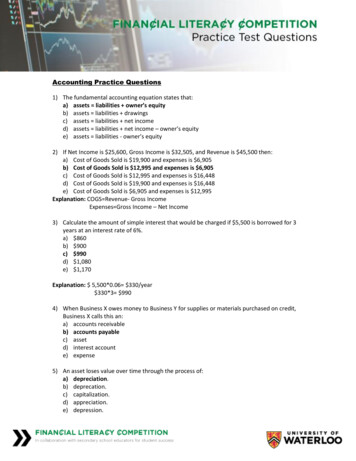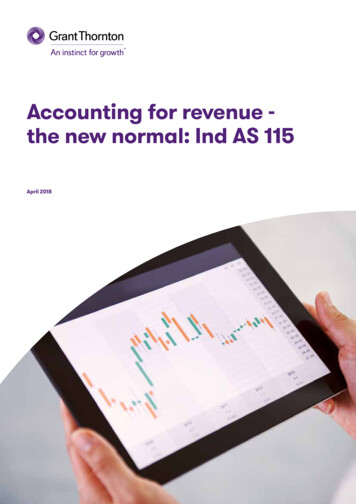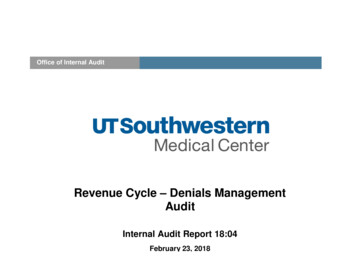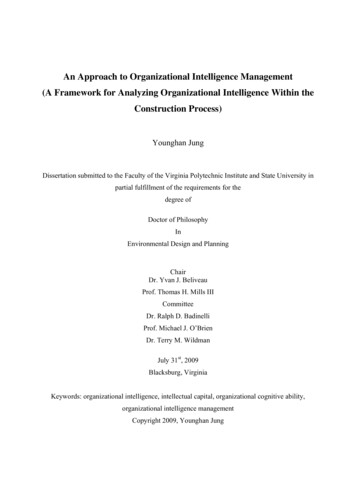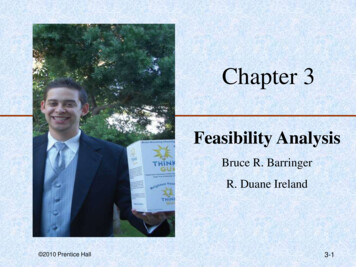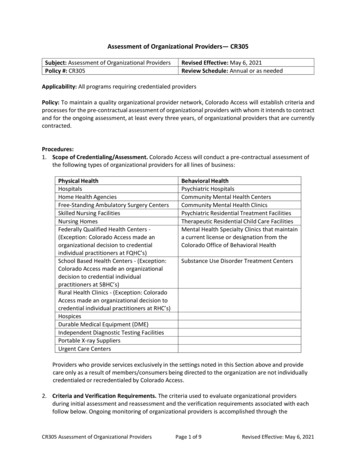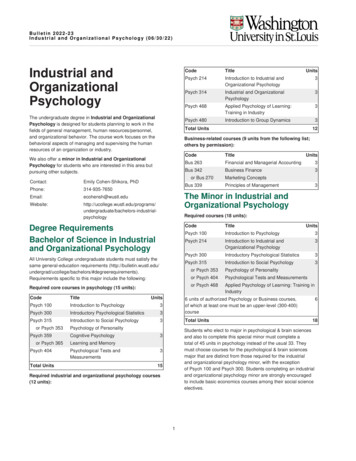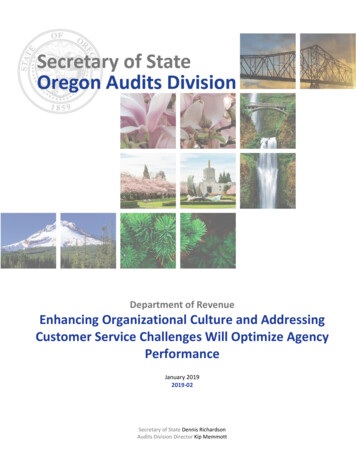
Transcription
Department of RevenueEnhancing Organizational Culture and AddressingCustomer Service Challenges Will Optimize AgencyPerformanceJanuary 20192019-02Secretary of State Dennis RichardsonAudits Division Director Kip Memmott
This page intentionally left blank
January 2019Department of RevenueEnhancing Organizational Culture and Addressing Customer Service ChallengesWill Optimize Agency PerformanceReport HighlightsOrganizational culture is key to shaping how members interact with each other and how they achieve theirmission and objectives. However, organizational culture in an organization, such as the Department of Revenue(DOR), can be difficult to assess or change. Both DOR staff and management have identified a desire to shifttoward a more collaborative agency culture and share perspectives on how culture can be enhanced to meetemployees’ needs. DOR leadership makes decisions regarding agency operations; this report providesinformation that can help inform some of those decisions. DOR leadership has been engaged with the audit andacknowledged that enhancing the culture is a good opportunity within the agency.BackgroundDOR has undergone tremendous change in the last five years. This includes several changes in leadershippositions, including the director, and implementation of a critical and expansive information technology system.These significant governance and operational changes affected both internal and external stakeholders. Forexample, DOR’s customer service rating decreased dramatically, drawing the attention of the Legislature in2017. We utilized a specialized methodology to assess how enhancing culture could help optimize the agency’sperformance. The DOR director has been supportive of our methodology and appears committed to enhancingthe agency’s culture.PurposeThe purpose of this audit was to determine how changes to DOR’s culture could improve agency performanceand to identify factors for the decline in customer service satisfaction from 2013 through 2016 that can beaddressed to enhance customer service moving forward.Key Findings1. Opportunities exist to enhance DOR’s operating culture and employee morale. Specifically, DORmanagement should develop a formal strategy and take action to better incorporate collaborative valueswithin the agency. The strategy should include robust internal communications, an effectiveaccountability framework, a collaborative feedback process, and improved workplace interactions.2. The agency’s customer satisfaction declined between 2013 and 2016. A portion of this decrease was dueto implementation of a critical and complex system known as GenTax. DOR has already identified andaddressed a number of customer service deficiencies; as a result, customer service ratings increased in2017 and 2018. DOR should complete efforts underway to address these challenges.RecommendationsWe made five recommendations to DOR for actions needed to improve its organizational culture and customersatisfaction. DOR agreed with all of our recommendations. The agency’s response can be found at the end of thereport.
IntroductionThe Department of Revenue (DOR) serves millions of Oregonians each year by collecting taxesand fees that fund the majority of public services in the state. Total revenue collected by theagency for the 2017-19 biennium is projected at 20.7 billion. Ninety percent of this revenue istransferred to the General Fund.Part of DOR’s mission is to preserve and enhance the quality of life for all Oregonians through itswork, which includes providing clear, accurate, and timely information and services that yield apositive customer experience.The purpose of this audit was to determine how changes to DOR’s culture could improve agencyperformance and to identify factors for the decline in customer service satisfaction from 2013through 2016 that can be addressed to enhance customer service moving forward. Our auditwork determined DOR can take action to enhance both the agency’s culture and customersatisfaction.DOR serves a critical function and has experienced significant personnel andoperational changes in recent yearsDOR administers Oregon tax programs and collects delinquent debtDOR administers nearly 40 tax programs, including the state’s personal income tax, corporationexcise tax, and property tax. DOR employees 1 are responsible for performing a number of taskssuch as processing returns, assisting and educating taxpayers, collecting delinquent debts, andenforcing filing requirements. DOR also collects and distributes taxes and fees for other stateagencies and local governments. These include 911 emergency communications tax, transitdistrict tax, marijuana tax, and court fines and fees.DOR’s legislatively adopted budget for 2017-19 was 313 million and includes 933 full timeequivalent staff. The agency has three major external service divisions: Property Tax, Personal1“Employees” in this report refers to all DOR staff, including line staff and different levels of management.Oregon Secretary of State Report 2019-02 January 2019 Page 1
Income Tax and Compliance, and Business Tax. Six district offices are located in different partsthe state.Figure 1: DOR has three major external service divisionsDivisionsDescriptionProperty TaxAdministers the statewide property tax system through partnerships withOregon’s 36 counties; directly administers timber and forestland programs,senior citizen property tax deferral, and nonprofit housing for the elderly.Personal Income Taxand ComplianceDirects and manages the state’s personal income tax program, including taxpolicy, collection, audit, and filing enforcement functions. This division alsohandles the majority of the agency’s customer service work.Business TaxPerforms collection, audit, filing enforcement, and tax policy functions forcorporations, partnerships, and entities other than individuals for income taxes.It also administers tax programs such as recreational marijuana, statewide transittax, and the state lodging tax, as well as collecting fees such as the petroleumload fee and hazardous substance fee.Source: DOR 2019-2021 Agency Requested Budget.DOR has experienced significant leadership and operational changes in recent yearsAfter 15 years under the same director, DOR had three different directors or interim directorsbetween December 2015 and October 2016. The current director has been in the position forapproximately two years. The leadership team has also changed in recent years. 2 Seven of the 11members of the leadership team have been in their positions for three years or less; four of theseven started in 2018. The current leadership’s priorities include stabilizing the agency after allthe changes and events in the recent years, implementing an agencywide accountability system,and rebuilding DOR’s credibility.In addition to high rates of executive management turnover, the department experienced asubstantive operational change in 2013 when DOR began implementing GenTax, a web-based,commercial, off-the-shelf tax processing software. DOR implemented GenTax in four majorrollouts, with the fourth rollout completed in November 2017. GenTax replaced most of DOR’slegacy core systems dating back to the 1980s and significantly changed some of the processesthat existed in the agency for decades. For example, some staff’s job descriptions changed orwent away and some staff had to shift their work duties to accommodate changes in the new taxprocessing system. In February 2018, our office issued an information technology auditexamining the GenTax system that concluded the system accurately processes tax returns andpayments. 3Legislative budget notes required a top-to-bottom assessment of DORAs DOR was going through changes in leadership and implementing the new GenTax system, itscustomer service key performance measure started to decline. 4 Specifically, the overall customersatisfaction rate went from 79% in 2013 to 13% in 2016. This drop, as well as communicationThe leadership team includes the director, deputy director, and division administrators.Audit Report no. 2018-08, “Oregon Department of Revenue: GenTax Accurately Processes Tax Returns and Payments, but LogicalAccess and Disaster Recovery Procedures Need Improvement.”4 Key performance measures are one way the Legislature monitors an agency’s performance. This key performance measure depictsthe percent of customers rating satisfaction with DOR’s customer service as “good” or “excellent” based on overall experience,timeliness, accuracy, helpfulness, expertise, and availability of information.23Oregon Secretary of State Report 2019-02 January 2019 Page 2
issues that arose during DOR’s appearances at legislative hearings in 2017, caused concernamong some legislators about the agency’s financial management, personnel practices, and poorcustomer service.These concerns led to nine adopted budget notes in the 2017 legislative session directing DOR toundergo several reviews by different entities, including the Secretary of State Audits Division.The reviews included a comprehensive external audit, an outcome-based managementassessment by a private firm, a comprehensive review of personnel practices and legislativelyauthorized positions, and a self-assessment to identify deficiencies in the delivery of taxpayerassistance. As of October 30, 2018, DOR had completed its response to six of the nine budgetnotes.Our office conducted a separate review of DOR’s Core System Replacement (CSR) called for inone of the nine budget notes. 5 Part of this review was to determine, among other things, theappropriate use of bond funds, appropriate use of General Fund monies, and if the contract withthe vendor that implemented CSR met legal sufficiency requirements. The review concludedDOR’s expenditures were documented and consistent with the purpose of the bond sales,General Fund expenditures were reasonable and appropriate for the purpose of the CSR project,and contract and amendments with the CSR vendor met legal sufficiency.Auditing organizational culture is a relatively new and emerging area,requiring a specialized methodology to draw conclusionsWhile auditors often emphasize the importance of the organizational governance concept of“tone at the top,” auditing organizational culture is a relatively new concept. Organizationalcultures drive performance. However, it is challenging to define culture, let alone quantify,measure, or audit it. To conduct a performance audit of organizational culture at DOR, the auditteam deployed a generally accepted social science tool that has been used at thousands oforganizations worldwide to enhance performance, but never before within an auditing context.Organizational culture entails the values, beliefs, and behavioral norms of organizationalmembers and affects performanceOrganizational culture has several definitions. For the purpose of this audit, organizationalculture is defined as basic assumptions and beliefs that are shared by members of anorganization.Most successful companies have one thing in common that separates them from theircompetitors — their distinct organizational culture. Research indicates the sustained success ofthese organizations has more to do with their values, beliefs, and vision, rather than theirmarket forces, competitive positioning, or resource advantage. 6Organizational culture determines performance across different organizations in both the publicand private sectors. Organizations with strong values can increase their performance comparedto those without. As an example, organizations see their productivity and effectiveness in theform of profits, revenues, job satisfaction, quality, customer service, organizational commitment,performance, and a reduction in the number of errors. 7Management Letter no. 150-2018-11-01, “Review of Core System Replacement project.”Kim S. Cameron and Robert E. Quinn, Diagnosing and Changing Organizational Culture Based on the Competing Values Framework(California: Jossey-Bass, 2006), 47 Marcella Bremer, “What is Culture and Why Does it Matter?” in Developing a Positive Culture where People and Performance Thrive(Melbourne, Florida: Motivational Press, Inc., 2018), 2056Oregon Secretary of State Report 2019-02 January 2019 Page 3
Organizations have different options to enhance performance. Some of the most commonorganizational change initiatives are total quality management, downsizing, and reengineering.These initiatives are intended to improve productivity, efficiency, competiveness, andeffectiveness of organizations. Research, however, shows these initiatives often fail because theyare not accompanied by a fundamental change in organizational culture. Organizations may havethe tools and techniques and the change strategy may have been implemented with vigor, butefforts for improvement fail because the values, ways of thinking, and managerial styles remainthe same.The Organizational Culture Assessment Instrument helps to identify current and preferredculture traits for organizationsKey Dimensions ofOrganizational Culture1.Dominantcharacteristics of theorganizationLeadership styleManagement ofemployeesOrganizational gluethat holds theorganization togetherStrategic emphasisCriteria of success2.3.4.5.6.We used the Organizational Culture Assessment Instrument (OCAI)for this audit. OCAI is a survey tool created by two professors fromthe University of Michigan that is used to assess six key dimensionsof organizational culture. More than 10,000 organizationsworldwide have used this tool.The tool uses a points system and averages based on surveyresponses to produce a culture profile showing the differencebetween the current culture — the fundamental assumptions onwhich an organization operates and the values that characterizethem — and the preferred culture. The creators assert thataddressing this difference in the culture will result in improvedemployee and organizational performance.The OCAI is a descriptive model and does not make a valuejudgment on one culture over another. Similarly, there are no rightSource: Organizationalor wrong answers to the survey questions, as there is no right orCulture Assessmentwrong culture according to this framework. Furthermore, asInstrumentculture is more of an abstract concept than a tangible metric,assessing or auditing it can be difficult; any tool that attempts to doso will necessarily have its limitations. Our audit findings should be viewed within this context.There are several tools to assess organizational culture, but the OCAI is useful and accurate inboth diagnosing important aspects of an organization’s underlying culture and predictingorganizational performance. Sufficient evidence has been produced to confirm the reliability andthe validity of the OCAI and researchers are confident the tool matches or exceeds the reliabilityof the most commonly used instruments in the social and organizational sciences. Empiricalevidence also show the OCAI is valid — that is, it measures what it claims to measure, which arethe key dimensions of organizational culture that significantly impact organizations andindividual behaviors.The OCAI identifies the current and preferred culture according to four culture types: Clan: A friendly place to work where people share a lot of themselves. Leaders arementors. The organization emphasizes the long-term benefit of human resourcesdevelopment and morale is important. The organization also emphasizes teamwork andparticipation. The verb that is often used to identify this culture type is collaborate.Adhocracy: A dynamic, entrepreneurial, and creative place to work. Leaders areinnovators and risk takers. The organization encourages individual initiatives andfreedom. The verb that is often used to identify this culture type is create.Oregon Secretary of State Report 2019-02 January 2019 Page 4
Market: A results-oriented place to work where the major concern is getting the jobdone. Leaders are hard drivers, producers, and competitors. Reputation and success arecommon concerns. The verb that is often used to identify this culture type is compete.Hierarchy: A formalized and structured place to work. Procedures govern what peopledo. Leaders are coordinators and organizers. Stability, predictability, and efficiency arelong-term concerns of an organization. The verb that is often used to identify this culturetype is control.The OCAI survey shows DOR employees who responded to the survey prefer a collaborativecultureWe used the OCAI to survey 857 DOR employees. A little over half of the employees — 52% —responded to the survey. The collective results show the agency’s current culture as hierarchyand the preferred culture as clan, as depicted in Figure 2. 8 The tool also measures the differencebetween the two cultures in terms of percentage points, which can indicate when results areespecially relevant and should induce an organization to take action. Our survey resultsindicated the difference was significant enough that DOR met this threshold. 9Figure 2: While all four culture types are present at DOR, employees identified the current culture ashierarchy, but prefer the clan cultureSource: DOR employee survey results.The current hierarchy culture reflects, in part, employees’ belief that a highly structured workenvironment is critical for a regulatory agency like DOR. Important values are attributed toThroughout this report, we use the term “collaborative” to describe the clan culture employees prefer.According to the researchers behind the survey instrument, differences over 10 points are considered especially relevant. Oursurvey showed a decrease in 11.68 points in the current culture and a 10.23 increase for the preferred culture.89Oregon Secretary of State Report 2019-02 January 2019 Page 5
DOR’s current culture such as a formalized and structured place to work. Additionally, rules,policies, and procedures provide guidance on how work should be done. There is also a generalfocus on maintaining an efficiently run agency and employees are provided with securedemployment. These values help ensure DOR is collecting taxes correctly, fairly, and equitablyaccording to tax laws.The more collaborative culture that employees desire has important values as well. These valuesinclude people-oriented qualities, such as loyalty, commitment, human resource management,and morale. This people-oriented culture also emphasizes sensitivity to customers and concernfor people, teamwork, and participation. These values help ensure DOR employees collaborateand support each other to come up with effective ways to optimize performance.Furthermore, responses about current and preferred culture were consistent across themajority of the demographic groups involved. These groups were broken down by age, gender,years of service, and management status, among others. Refer to Appendix B for thedemographics included in the culture survey.DOR employees acknowledged that values of a collaborative culture could be incorporated intothe current work environment while maintaining the hierarchy values that contribute to DOR’srole as a regulatory agency.Focus groups and interviews identified ways to enhance DOR’s cultureWhile the OCAI survey results provide culture profiles for the current and preferred cultures atDOR, additional information was needed to understand how the difference between current andpreferred cultures manifest within the agency — and what can be done to bridge the gap. Togather this information, we constructed focusgroup sessions to discuss and gatherinformation from employees. These sessions,in addition to reviewing agency data andindividual interviews, provided importantqualitative data that informed the auditfindings.Setup for the focus group sessions at DOR. A total of 136 employeesparticipated in 17 focus group sessions.A total of 136 employees from variousworkgroups, classifications, and divisionswithin DOR participated in 17 focus groupsessions. We held three separate sessions formembers of the leadership team, middlemanagement, and line managers. 10 Themajority of the participants were line staff.DOR leadership was receptive to the audit methodology and reported the audit work wouldprovide useful information for the agency and complement some of the work the agency will bedoing in the future.10Throughout this report, we use the term “managers” to refer to middle managers and line managers.Oregon Secretary of State Report 2019-02 January 2019 Page 6
ObjectiveObjective, Scope, and MethodologyWe had two objectives for this audit. The first was to determine whether current organizationalculture at DOR is consistent with its employees’ preferred state, and whether addressing thecultural inconsistencies could help address organizational performance.The second was to identify factors for the decline in customer service satisfaction from 2013through 2016 that can be addressed to enhance customer service moving ahead.ScopeOur audit scope included an agencywide culture assessment and customer service work.MethodologyTo complete our first audit objective, we administered an agencywide survey to 857 DORemployees to assess the agency’s culture using the OCAI. The survey response rate was 52%. Asnoted, this tool identifies the difference between the agency’s current and preferred culture, andsets the stage for discussions on opportunities to enhance DOR’s culture. A detailed descriptionof the OCAI can be found in Appendix A, including information on the instrument’s reliability andvalidity. Appendix C includes a list of the survey questions.We supplemented the survey with 17 focus group discussions in which 136 employeesparticipated. Participants included members of the leadership team, mid-level and line levelmanagers, staff from field offices, and staff from five work groups suggested by DOR leadership: ;Policy/Systems; andOther (employees that do not fall in any of the groups above).These work groups are made of different employee classifications such as tax auditors, revenueagents, administrative specialists, office specialists, and operations and policy analysts, to namea few.For both audit objectives, we also conducted interviews with members of DOR’s leadershipteam, program managers, line staff, and union representatives. We also reviewed agency policiesand procedures, reports to the Legislature, employee engagement reports, key performancemeasures reports, and researched methods, approaches, and tools for assessing organizationalculture and the connection between culture and performance.We conducted this performance audit in accordance with generally accepted governmentauditing standards. Those standards require that we plan and perform the audit to obtainsufficient, appropriate evidence to provide a reasonable basis for our findings and conclusionsbased on our audit objective. We believe that the evidence obtained provides a reasonable basisfor our findings and conclusions based on our audit objectives.We sincerely appreciate the courtesies and cooperation extended by officials and employees ofDOR during the course of this audit.Oregon Secretary of State Report 2019-02 January 2019 Page 7
Audit ResultsOur assessment of DOR culture found that while employees appreciate the more structured andhierarchal culture that currently exists, the agency’s culture could be enhanced by implementingmore collaborative values.We held extensive and diverse focus groups to explore ways increased collaborative valuescould be incorporated into the agency’s current culture. Employees, a term encompassing boththe management team and staff members, reported that a clan culture can be achieved byimproving communication, through an effective accountability system and feedback processes,and improved workplace relationships. By bringing the agency culture into better alignmentwith the collaborative values employees prefer, DOR will be able to optimize its performance.A more collaborative culture would also enhance the agency’s ongoing efforts to addressdeficiencies in customer service.DOR leadership can improve collaboration by clearly communicatingsignificant changes and how they align with the agency’s vision and directionDOR employees identified multiple instances of unclear agency communications, including a lackof clarity about the agency’s direction and vision; frustration regarding significant changes ininternal communications and staff access to the director; the rationale for a significant change incustomer calls protocols and processes; and the agency’s increased emphasis on outcomemetrics as opposed to quality customer service. In focus group sessions, both staff and managersexpressed the opportunity and need for enhancing agency communications.Effective communication from management is critical as it informs staff what they are supposedto do in the workplace. 11 Effective communication is also essential as it can build relationships,foster trust, and increase efficiency and effectiveness in the workplace. According to theCommittee of Sponsoring Organizations and the GovernmentAccountability Office, information and communications are“I don’t understand how my jobvital to identify, assess, and respond to risks on an ongoingfits into the bigger picture.”basis and ensure achievement of objectives. 12 Managementshould internally communicate necessary and quality-Focus Group Participantinformation to achieve the organization’s objectives. 13“I would like more visibility bythe director. I don’t feel I knowher or her priorities very well.”“Sometimes there is a lot ofdecisions from management thatmake the everyday employeequestion the direction.”-DOR Employee EngagementSurvey responses 2017Employees are unclear of DOR’s direction and prioritiesLike many state agencies, DOR has a specific mission andespoused vision and values that express the essence of theagency and how management and staff wish to carry out theirfunctions. Despite having these values, vision, and mission,some DOR staff and managers are still unclear on the agency’sdirection, as they cannot see how it connects to their dailywork. That was reinforced during focus group sessions, whenstaff expressed a lack of clarity regarding the agency’s currentdirection and priorities. Staff also could not identify how theyManagement in the context of people, as oppose to strategy, refers to members of the leadership team, middle managers, and linemanagers.12 DeLoach and Thomson, “Improving Organizational Performance and Governance: How the COSO Frameworks Can Help,“Committee of Sponsoring Organizations of the Treadway Commission13 Comptroller General of the United States, “Standards of Internal Control in the Federal Government,” U.S. GovernmentAccountability Office11Oregon Secretary of State Report 2019-02 January 2019 Page 8
and their work fit within the agency’s vision. Some managers, as well as members of theleadership team, expressed the need for everyone to have a sense of both how they contribute tothe agency’s mission and where the agency is going.One way to help inform employees of the agency’s direction, goals, and strategies is through astrategic plan. This plan is used by agency leadership to communicate organization goals and theactions needed to achieve those goals. DOR leadership is working to update their 2015 strategicplan as part of an outcome-based management initiative brought forward at the request of theLegislature. When the plan is updated, DOR leadership should ensure the plan is clearlycommunicated to employees at all levels within the agency.DOR leadership can more clearly communicate the intent of significant operational,personnel, or policy changesThe current director implemented a series of changes impacting internal communications andlimiting staff access to the director. While these changes were intentional, agency leadership didnot communicate them as effectively as they could have, leaving DOR personnel unclear as to thereason and impact of the changes.As noted, the department underwent a critical and complex information technologyimplementation over the last few years. The prior director adopted an expansive communicationapproach to ensure a successful implementation of this system, communicating frequently anddirectly with personnel. For example, the agency used to hold monthly town hall meetings andvideo messages from the DOR director. Staff also frequently contacted the director directly withissues or concerns.Now that the system has been implemented, the currentleadership strategy involves less frequent communication. Theleadership team now conducts town hall meetings on aquarterly basis and provides fewer video messages. Employeeshave noticed the change in communication, but have not beengiven an explanation as to why. Leadership is still determiningthe appropriate level of information for staff to receive in orderto do their jobs and is working to reinstate the use of the chainof command for communications from staff and to ensurecommunications from leadership are relevant and meaningful.Leadership can use the recently implemented newsletter tocommunicate relevant information to staff.Communication is a complex and elusive managementresponsibility. Properly calibrating the level of communicationin terms of too much or not enough is an inherent challenge oforganizational management.Effective internalcommunications should: Build relationshipsBuild a sense of communityFoster trustEnsure everyone gets thesame message at the sametimeEnhance informed decisionsthrough information sharingLead to improvedperformanceIncrease efficiency andeffectivenessEmpower staffSource: Internal AuditorJournal, 2000DOR has systems in place such as GenTax and Automated CallDistribution (ACD) that that allow managers to monitor staffproductivity and staff to monitor their own productivit
Auditing organizational culture is a relatively new and emerging area, requiring a specialized methodology to draw conclusions . While auditors often emphasize the importance of the organizational governance concept of "tone at the top," auditing organizational culture is a relatively new concept. Organizational cultures drive performance.



